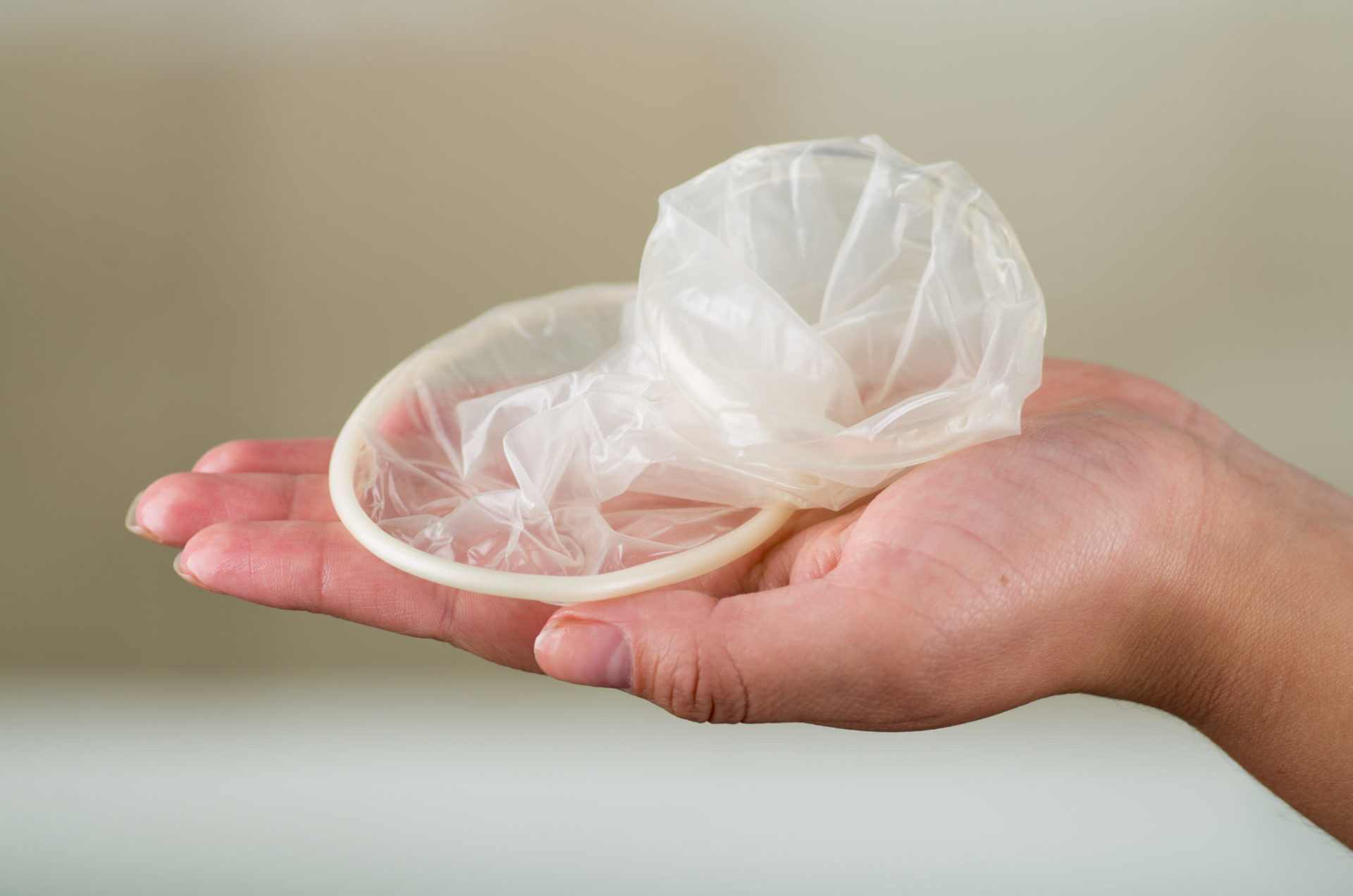The female condom, also known as the internal condom, is an alternative to the male condom. Instead of going on the penis, it goes into the vagina or anus to prevent sexually transmitted infections (STIs), including HIV, and pregnancy.
For the rest of this article, we will refer to this device as the ‘internal condom’ rather than the ‘female condom’.
Some people prefer to use the internal condom, that way they don’t have to rely on their partner to wear a condom. If you’ve never used an internal condom, it’s good to know – and even try – all the options. You might be surprised to discover what works best for you.
What is the internal condom?
The internal condom is a thin piece of latex or nitrile that is inserted inside the anus/vagina to prevent a sexually transmitted infection, including HIV (or an unwanted pregnancy, in the case of vaginal sex).
How does an internal condom work?
The internal condom is placed inside the anus or vagina and creates a barrier that prevents bodily fluids and semen from entering the partner’s body. When used correctly, it helps prevent pregnancy, STIs and HIV.
How is the internal condom used for anal sex?
Although they may seem daunting at first, internal condoms are easy to use with a little practice.
You’ll find instructions in the packet on how to use it for vaginal sex, but you can get information on how to use an internal condom from a Checkpoint counsellor.
- Check the expiry date and whether it looks in good condition.
- Carefully take the condom out of the packaging so you don’t break it (don’t use teeth or scissors, and be careful of fingernails or jewellery).
- The easiest way to use the internal condom for anal sex is to wear it as a ‘male’ condom. Put lube inside the internal condom and then put it over your penis (or dildo). Also put lube on the outside of the inner condom or around the anus before sex.
- However, an alternative method is to insert the internal condom into the rectum, as with vaginal sex. If you try this, put lubricant around the anus and relax it with a finger, preparing it for the internal condom. Make sure your nails are trimmed short.
- After removing the internal condom from the wrapper, hold the inner ring between your thumb, index and forefinger and squeeze it so it forms an oval. Although some people remove the inner ring, this can cause the condom to break.
- If you don’t put the inner condom on the penis, push it into the rectum as deep as you can. Use the inner ring as a guide while gently pulling the anus with your other hand. Then insert your index finger into the inner condom until you feel the underside of the inner ring. Push up as far as you can, but don’t insert the outer ring.
- You’ll find that the outer ring, and perhaps part of the inner condom, is on the outside of your anus. It has to be that way to stop the inner condom from sliding inside your anus.
- Use plenty of lube inside the condom to keep it moist, and add more whenever you need it during sex.
- Check from time to time during sex that the outer ring of the inner condom has not slipped into the anus or that the penis has not slipped between the inner condom and the anus. If this has happened, stop, remove the inner condom and use a new one before resuming intercourse.
- Finally, remove the inner condom. Because it is inside the rectum, the partner does not have to pull out immediately after ejaculation. Remove the condom carefully so that the contents do not spill out. Twist the outer ring three times to keep the seminal fluid inside, then pull gently until it is all the way out. Throw it in the bin, not the toilet.
- Do not reuse the inner condom. It’s designed for one use only – using it more than once or with more than one partner will most likely break it.
Don’t double condoms! Using an internal condom at the same time as a male condom causes friction and therefore both will break.
Internal Condom Vs External Condom
Internal condoms have advantages and disadvantages compared to male condoms and it’s good to find out what suits you. Here are some things to think about when evaluating your options:
Effectiveness
Internal condoms can be just as effective as male condoms when used consistently and correctly.
No interruptions
Unlike male condoms that are put on just before sex or during sex, you can insert the condom internally beforehand (up to eight hours before sex). This means there are no interruptions once you decide to have sex. It also means that the penis can be inserted into the anus or vagina before it is fully erect.
So not only does this allow you to take care of your own sexual health, but it won’t interrupt you during sex.
Latex
While most (not all) male condoms are made from latex, female condoms are made from a soft, plastic product called nitrile. This is hypoallergenic, which means that internal condoms won’t irritate sensitive genital skin.
In addition, while male condoms cannot be used with oil-based lubricants, as these can cause the latex to break down, internal condoms can be used with any type of lubricant – whether oil, water or silicone!
Size matters
Internal condoms are larger than male condoms and do not stay fixed around the penis. This means they give your partner’s penis a larger ‘breathing zone’, which for some is more comfortable and helpful in maintaining an erection. Many men prefer to use internal condoms for exactly this reason.
Maximum pleasure
Using internal condoms can make sex more pleasurable for both men and women.
During sex, the inner ring of the inner condom can stimulate the tip of the penis and the outer ring can rub the clitoris (in the case of vaginal sex) – this can be great for both of you!
You can also ask your partner to put the inner condom on for you as part of foreplay.
Relax!
Because the internal condom doesn’t depend on an erection to stay in place, your partner doesn’t have to pull out immediately after ejaculation like they would with the male condom. The internal condom can be removed when you want it to, just make sure no semen is leaking out of it.
This means you can relax after sex and simply enjoy the moment together.
What should you do if an internal condom breaks?
An internal condom is unlikely to break, especially if used correctly. However, if an internal condom breaks or leaks semen when it is removed from the anus/vagina, or if the outer ring moves inside the vagina – or if something else goes wrong and the penis slips between the condom and anus/vagina during sex, then there are a few simple things you can do:
- withdraw the penis immediately
- remove as much semen as you can
- avoid washing in the anus/vagina as this can push semen/secretion in and cause irritation
- if you have not used any other contraceptive to prevent pregnancy, consider taking emergency contraception within 72 hours of sexual contact.
What should I do if the condom breaks and my partner is HIV-positive?
Your HIV-positive partner will be able to tell you if he or she is taking regular treatment and has been undetectable for at least the last 6 months. If so, the risk of HIV transmission if the condom breaks is extremely low. However, both of you may decide to get tested for other STIs.
If a condom breaks and your HIV-positive partner is not on regular treatment, or if you’re not sure how well they’ve taken it, you’ll need to see a doctor as soon as possible (within 72 hours). Your doctor may recommend Post Exposure Prophylaxis (PEP). This is a month-long course of antiretroviral (ARV) drugs that reduce your chances of getting HIV.
PEP has a high success rate; however, it is not a replacement for condoms. PEP is a powerful drug that has side effects and is not an option available to everyone.
If you are in a relationship with someone living with HIV, using Pre-Exposure Prophylaxis (PrEP) may be another option to protect yourself from the risk of HIV transmission. However, it won’t protect you from other STIs or unwanted pregnancy.
Where can I find internal condoms?
Although internal condoms are not as easy to find as male condoms (and can be more expensive), you can usually get them from shops or online pharmacies (most often under the name of female condom).
The internal condom is available in 130 countries. There are different types of female condoms, but common brand names include Femidom, Dominique, Femy, Myfemy, Protectiv, Elegance, Della and Care.
There are new models of internal condoms being developed and produced around the world, which aim to be more comfortable and easier to use.

